Welcome, dear listener. Today, being short of elephants, we’re going to address the Carnacki in the room. If you have no idea what we’re talking about, then let us speak plainly. A few years before his death in the First World War, a man called William Hope Hodgson wrote nine short stories about a British occult detective, though only six were published in his lifetime. Oh, and it turns out that not all of the stories were actually occult.
They were moderately popular. And that’s it.
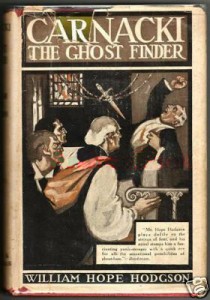
So, onto our longdog Django and his peculiar obsession with that polystyrene box in the garden…
No, wait. Something else happened, and most of it happened in the last twenty five years. More than a dozen writers have produced, or are still producing, tales which draw on Hope Hodgson’s Carnacki the Ghostfinder. Which is slightly surprising, really. You can divide these fellows and fellowesses into two broad groups, though they occasionally blend and recombine, like peculiar literary sponges (Most links given are UK sources, because we’re lazy).
1. The Canonical Explorers
The Canonical Explorers have two great virtues. The first is that their stories are tales of Carnacki himself – they add directly to the original nine tales. The second is that they tease out the techniques, equipment and mythologies mentioned in the originals and do new things, but in the spirit of the old. We can’t name everyone, but three Explorers who stand out by virtue of repeated expeditions into this territory are authors Willie Meikle, Chico Kidd and Brandon Barrows.
Willie Meikle is the most prolific Explorer so far, with two full collections of Carnacki stories, some individual tales and a novella reflecting back on a piece of Carnackian technology. Willie takes Hodgsonian themes and devices one step further, and brings his particular sense of adventure and excitement to the Carnacki game. His excellent collection Carnacki: Heaven and Hell is readily available, as is the related but non-Carnacki novella Pentacle. The collection Watcher at the Gate is also available, though a tad more expensive.
Chico Kidd is the earliest Explorer, having produced a whole set of Carnacki stories in 1992 (with Rick Kennett) – and with a hint of her returning to the fold even now. Her collection is No. 472 Cheyne Walk: Carnacki, the Untold Stories, and is ideal for those who want more canonical tales.
To Brandon Barrows we give the accolade of being the most recent serial offender. His collection, The Castle-Town Tragedy, three Carnacki novellas, was produced as a limited edition, but there are rumours that paperback and e-format may follow, and he too may have more Carnacki short stories to come.
2. The Post-Mortem Voyagers
The Post-Mortem Voyagers have a single common factor: Carnacki is dead, so someone has to roll up their sleeves and get on with it. Their tales are therefore set in the late Edwardian period and after. Perhaps the most notable of this group is Josh Reynolds, with the old greydog himself, John Linwood Grant, wandering along behind.
Josh Reynolds has taken the ‘After Carnacki’ bull by the horns and produced a whole series of dashing tales concerning the Royal Occultist. Charles St Cyprian is the direct inheritor of Thomas Carnacki’s role as (you guessed) the Royal Occultist, and with his feisty ‘assistant’ Ebe Gallowglass, engages in uncanny investigations across the first half of the 20th century. The psychic defence of the Empire itself falls on their shoulders during the process. There are numerous tales, including three major books – The Whitechapel Demon, The Jade Suit of Death and The infernal Express, as well as the novella The Door of Eternal Night.
John Linwood Grant became curious about those who patiently sat and listened to Carnacki reciting his adventures, and therefore took a different route. His Tales of the Last Edwardian are about the human side of that audience, and what they do when Carnacki is no more. His stories focus mainly on Henry Dodgson, the narrator in the originals, and the psychic Abigail Jessop, niece of another of Carnacki’s ‘gang’, as they throw themselves into a world of hidden occult and psychic threats, gathering allies such as the alienist Dr Alice Urquhart, Captain Redvers Blake of Military Intelligence and others.
Dodgson, Jessop and Blake can be seen in his novella A Study in Grey, three free taster stories on Smashwords, and in other stories being anthologised over 2016. An ‘origins’ novel, The House of Clay, is also in progress (so he says).
As we referred earlier to blending and recombining, both Josh Reynolds and John Linwood Grant have also written the odd Canonical Explorer tale of Carnacki himself (see anthologies below).
Sam Gafford, Hope Hodgson scholar, editor and writer, deserves credit for being one of the main people who has worked to keep Carnacki (and Hope Hodgson in general) in the limelight. In the process he has published two relevant anthologies – Carnacki: The New Adventures and Carnacki: The Lost Cases. Several of the above authors are included in these two volumes, with the additional note that writers Charles R Rutledge and Robert M Price have also appeared in both.
There’s even been a high quality audio adaptation of six of the Carnacki stories this year, by Big Finish Productions, which we covered at the time. It is excellent, both evocative and faithful to the original tales.

You can read our full piece on the audio production here: carnacki lives!
Why Carnacki?
Is there a reason why Carnacki continues to be popular with writers and readers? Yes. Yes there is. Oh, you want to know? We covered some of this in our Hope Hodgson festival last October, but it does no harm to recap and extend the argument we made back then. We see three key reasons, actually.
- He’s an occult detective where you can never be sure if his case is occult or not. This was a great twist at a time when you were supposed to be writing either supernatural stories or good old fashioned crime/mystery stories. Hope Hodgson did both, and cleverly.
- His mythology, monstrosities and methods were, for the most part, Hodgson’s own invention, not cobbled together from a quick scan of an old occult tract. Much of what he includes is quite original, and still stands up well – the Hog, the Outer Circle, the rituals and the innovative use of electrical equipment.
- He was merely mortal.
It’s easy to read the original cases and miss what makes Carnacki stand out from the rest. H P Lovecraft, who made many insightful comments about weird and supernatural fiction, got it entirely wrong. The stories were clearly not to his taste, because he didn’t bother to think harder about them. He wrote, of Carnacki:
“We here find a more or less conventional stock figure of the “infallible detective” type – the progeny of M. Dupin and Sherlock Holmes, and the close kin of Algernon Blackwood’s John Silence.”
Supernatural Horror in Literature H P Lovecraft (1927, revised up to 1935)
Which is demonstrably untrue. David Stuart Davies, who has edited and annotated many collections of period supernatural tales, says:
“Hodgson succeeds – where other creators of occult detectives fail – in bringing a realism to the narratives because his character is not superhuman, infallible and all-knowing, but highly vulnerable while at the same time very brave.”
This is not Sherlock Holmes. Carnacki never sweeps into a room wielding his intellect and says “As I deduced. The ghost is under the third armchair, you have obviously spent some time in New Guinea recently and your sister-in-law is having an affair with a left-handed coalman.”
He photographs the furniture over a number of nights, asks where people have been, and then sets traps in case the coalman really is involved somehow. And then, when it appears that the coalman is innocent, he crouches there taut with fear as something more horrible come to light. Sometimes he can’t even fully explain what the horror is, even when he’s dealt with it.
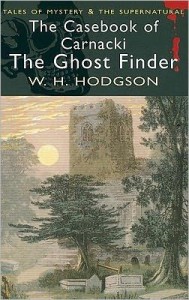
As for John Silence, let’s draw directly from the texts on this one, in case you think we’re prejudiced. Take this example of the difference between Carnacki and Silence, which we’ve used before. The first is Dr John Silence, sitting in a haunted room in A Psychical Invasion (1908):
For this spiritual alchemy he had learned. He understood that force ultimately is everywhere one and the same; it is the motive behind that makes it good or evil; and his motive was entirely unselfish. He knew—provided he was not first robbed of self-control—how vicariously to absorb these evil radiations into himself and change them magically into his own good purposes. And, since his motive was pure and his soul fearless, they could not work him harm.
Measured and self-confident, eh? Now Thomas Carnacki, also sitting in a haunted room in The Gateway of the Monster (1910):
“I knelt again in the centre of the pentacles, watching myself with more fear, almost, than the monster; for I knew now that, unless I guarded myself from every sudden impulse that came to me, I might simply work my own destruction. Do you see how horrible it all was?
“I spent the rest of the night in a haze of sick fright, and so tense that I could not make a single movement naturally. I was in such fear that any desire for action that came to me might be prompted by the Influence that I knew was at work on me.”

This is an entirely different kettle of spaniels. Carnacki isn’t pure or fearless, he’s close to needing a new pair of pants. From Gateway again:
“I was on my knees, and I jerked back, falling on to my left hand and hip, in a wild endeavour to get back from the advancing thing. With my right hand I was grabbing madly for my revolver, which I had let slip… I believe I yelled.”
The stock figure and progeny of Sherlock Holmes, eh? Hardly. This is the kind of occult detective that I can get my head round. When asked what the hell is going on, he doesn’t make up guff about having worked it all out halfway through the case. He admits puzzlement and doubt. He tells his friends how scared he was, and how much he wanted to get out of there. He runs away, when prudence demands it. He even considers suicide in one tale:
“I whirled round, sick with fear… I fumbled for a mad instant at my revolver, not for it, but for myself…”
There are numerous examples of a man struggling against his own instincts to face extreme danger throughout the stories, as Davies says.
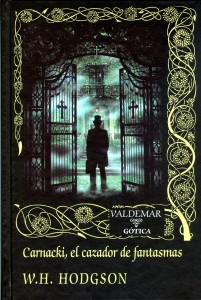
(As a side-note, concerning criticism of the ritualistic way he summoned and dismissed his friends, we have no problem with that because Hope Hodgson was not writing about the private life of Carnacki. He chose those key moments of story-telling as his vehicle for presenting the cases of the Ghostfinder. Why not?)
We still argue therefore, as we did last year, that he deserves a place in our hearts. And if you want to know what we think about the real Carnacki, the man inside, then you can read Grey Dog, Linwood Grant’s story at the end of Carnacki: The Lost Cases.
“In the beginning I contrived our ritual – a handwritten invitation, a brusque greeting and a dinner which drew murmurs of pleasure. It was a way of dealing with those awkward first meetings, to pretend that Cheyne Walk was almost a gentleman’s club. The only thing missing was the bent-backed old servant who hovered behind their chairs and murmured “More port, sir?”.
It was a mistake. Now, years later, they honour the ritual to the letter. I am suffocated by each pre-destined stage, but too cowardly to change it.”
jlg
Our case rests, and we are off, to regale you in a couple of days with something entirely different. We refuse to have one of those things that float on your screen and get in the way, but you can sign up to greydogtales.com for absolutely nothing (top left), and be warned of whatever nonsense comes next…
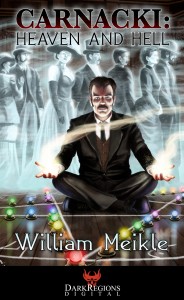 carnacki: heaven and hell
carnacki: heaven and hell
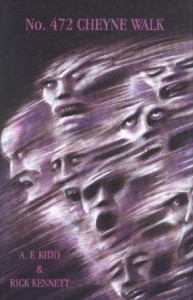 no. 472 cheyne walk
no. 472 cheyne walk
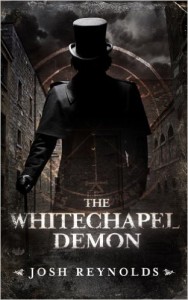 the whitechapel demon
the whitechapel demon the doors of eternal night
the doors of eternal night a study in grey
a study in grey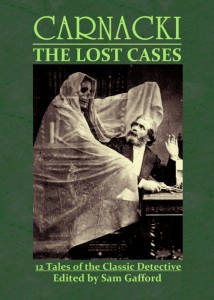
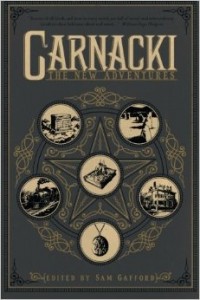 carnacki: the new adventures
carnacki: the new adventures
What sold the original stories to me was their utter charm, including the ritual dismissing of his audience at the end of the tale. And, of course, the fallibility and vulnerability of the hero.
Hi Jeff. Yes, they had a style of their own which I find I still enjoy. They stand up better than many occult-y tales of the period.